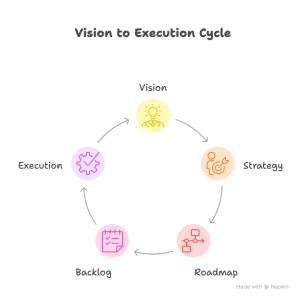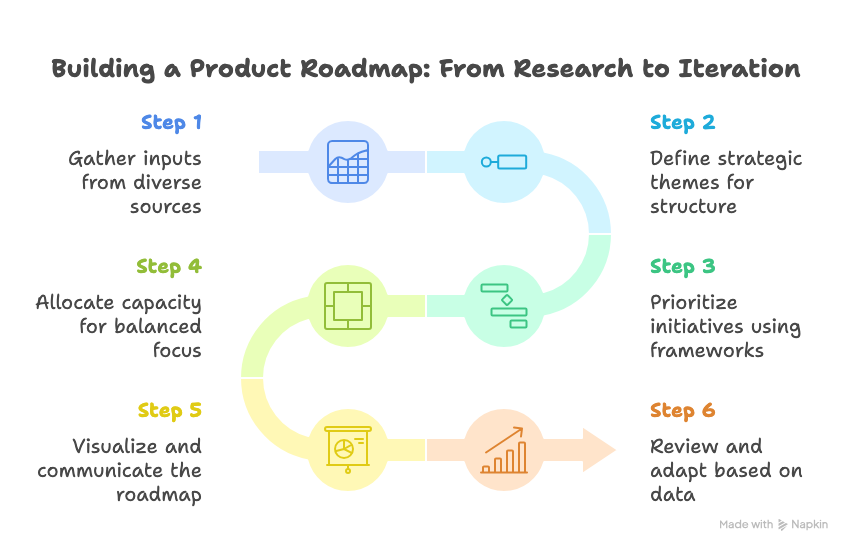Product Roadmap Guide: How to build, measure, and evolve a strategy that drives growth
October 21, 2025 • 12 min read

A great product roadmap is more than a plan, it’s a shared compass that guides a team toward a clear destination. It connects the product vision with what’s actually being delivered, helping teams align, prioritize, and make better decisions. Whether you’re a startup founder, a SaaS product manager, or a growing company trying to scale operations, a well-structured roadmap provides clarity and confidence.
This guide dives deep into what makes a roadmap effective, how to build one step by step, and how to measure and evolve it as your product matures. It also explores practical ways to avoid common pitfalls, integrate data-driven decision-making, and introduce strategic oversight, such as working with a Fractional Chief Product Officer (CPO).
Key takeaways:
- A product roadmap is a living strategic tool, not a fixed plan.
- There are multiple roadmap types, each serving a different audience and maturity level.
- Measuring roadmap success with KPIs ensures decisions are based on outcomes, not assumptions.
- Good governance and stakeholder alignment are what keep a roadmap relevant and trusted.
- Fractional CPOs can bring structure, strategy, and alignment to roadmap creation.
What is a product roadmap
A product roadmap is a strategic plan that outlines what a team intends to build and why. It bridges the gap between long-term vision and day-to-day execution, showing how short-term efforts contribute to larger business goals.
Unlike a backlog, which lists every potential task, a roadmap focuses on priorities, outcomes, and direction. It tells a story about how the product will evolve over time and provides visibility across teams.
Roadmap vs strategy vs backlog
- Strategy defines where the company is going and why.
- Roadmap translates that strategy into a sequence of goals, themes, or features.
- Backlog lists the granular work items needed to deliver on the roadmap.

Why product roadmaps matter
A roadmap ensures everyone, from leadership to engineering, understands what’s next and why. It helps prioritize what truly matters and prevents teams from chasing random opportunities.
Well-defined roadmaps bring:
- Alignment between departments and stakeholders.
- Transparency, reducing confusion and rework.
- Focus, by clarifying which ideas deserve attention now versus later.
- Accountability, ensuring progress is measurable and visible.
A clear roadmap also builds trust. When teams see consistent updates and reasoned changes, confidence in leadership and direction grows.
Types of product roadmaps
There’s no one-size-fits-all roadmap. The right format depends on your team size, company maturity, and audience.
| Type | Best for | Advantages | Drawbacks | Example use case |
| Timeline-based | Teams needing fixed deadlines | Easy to communicate | Can create rigidity | Hardware or regulated projects |
| Theme-based | Agile teams focusing on outcomes | Encourages flexibility | Lacks timeline clarity | SaaS teams iterating on feedback |
| Goal/outcome-based | Companies using OKRs | Aligns work to measurable goals | Needs clear metrics | Product-led startups |
| Portfolio roadmap | Multi-product companies | Great for cross-team alignment | Complex to maintain | Enterprises or holding groups |
| Hybrid | Growing teams with mixed needs | Balance between focus and flexibility | Requires discipline | Scaleups transitioning to structure |
Each roadmap type has a purpose, and companies often evolve from one to another as they mature.
When to use dates vs no-dates
The “should we include dates?” debate is ongoing. The answer depends on your team’s context and goals.
- Use dates when deadlines are non-negotiable, such as launches tied to marketing campaigns, compliance, or client contracts.
- Avoid dates when flexibility and discovery matter more than delivery precision. For example, early-stage SaaS teams benefit from outcome-based, undated roadmaps.
- Hybrid approach: Use quarters or broad time horizons (“Now, Next, Later”) to show sequencing without committing to fixed timelines.
The key is setting expectations. A roadmap should communicate confidence, not false certainty.
How to build a product roadmap (step-by-step)
Building a roadmap involves more than plotting ideas on a timeline. It’s about aligning business goals with customer value and organizational capacity.
Step 1: Gather inputs
Start by collecting insights from multiple sources: customer feedback, market trends, usage analytics, and internal strategy discussions.
Step 2: Define strategic themes
Group related ideas under broader themes such as “improving retention” or “expanding into new markets.” Themes provide structure and tie roadmap items back to objectives.
Step 3: Prioritize initiatives
Use frameworks like RICE, MoSCoW, or Kano to compare impact versus effort. Prioritization ensures resources focus on what creates measurable value.
Step 4: Allocate capacity
Balance the roadmap between new features, maintenance, technical debt, and innovation. A healthy split avoids short-term focus at the expense of scalability.
Step 5: Visualize and communicate
Select a roadmap format that resonates with your audience, and make it accessible to all stakeholders.
Step 6: Review and adapt
Set regular review cadences (monthly or quarterly). Update based on data, not opinions.

How to prioritize features and initiatives
Prioritization is where strategy meets reality. With limited resources, deciding what not to build is as important as what to include.
Popular frameworks
- RICE: (Reach, Impact, Confidence, Effort) – data-driven and scalable.
- MoSCoW: Must-have, Should-have, Could-have, Won’t-have – simple for stakeholder discussions.
- Kano Model: Helps balance user satisfaction with functionality improvements.
The most effective roadmaps combine quantitative models with qualitative insights. For example, customer interviews or usability data often reveal hidden priorities that metrics alone miss.
Roadmap governance and stakeholder alignment
Even the best roadmap fails without strong governance. Clear ownership prevents chaos and ensures alignment across the organization.
Define ownership
A CPO or Head of Product usually owns the roadmap, while product managers maintain individual sections. Engineering, design, and marketing contribute collaboratively.
Manage change
Establish version control and transparent communication. Every change should have a clear reason tied to data or strategy.
Maintain alignment
Hold regular roadmap reviews to discuss trade-offs, shifts, and dependencies. Encourage feedback but guard against “feature wishlists.”
This is where a fractional CPO can bring value. They introduce structure, facilitate strategic discussions, and bridge leadership with delivery teams, especially in startups or growing organizations.
Personal experience: When culture shapes the roadmap
I’ve always believed that the way a company defines its roadmap is a direct reflection of its organizational culture.
In one of the companies I advised, a very successful one, the roadmap was driven almost entirely by the loudest voices in the room. There was no clear prioritization framework or real connection between product initiatives and business goals. As a result, the development team, large and talented as it was, spent most of its time chasing requests that didn’t truly serve the company’s strategy.
The first step wasn’t to fix the roadmap itself but to change the mindset: to clarify that the product team’s role is not to fulfill internal requests but to drive the company forward by translating business goals into tangible product outcomes.
After a series of executive workshops and alignment sessions, we implemented a new process. Leadership first articulated the objectives they wanted to achieve for the upcoming quarter or year. The product team then translated those objectives into feature-level initiatives that could realistically move the key business metrics. Each proposed feature had to be supported by a measurable hypothesis and linked to an OKR.
Within two quarters, the change was remarkable. Delivery predictability improved by 25%, and internal satisfaction (measured through an anonymous survey) rose significantly. Most importantly, the company began discussing impact instead of output.
This experience reflects what Marty Cagan describes in Inspired: “Great product teams are not feature factories; they are problem solvers.” It also aligns with insights from Harvard Business Review about the qualities that elevate a product manager into a product leader, emphasizing influence, vision, and strategic thinking. Research from ProductPlan further shows that organizations with goal driven roadmaps achieve up to 30% higher alignment and faster decision cycles.
For me, this transformation captured the essence of true product leadership, creating shared understanding between strategy, execution, and culture, and turning the roadmap into a mirror that reflects that alignment.
Measuring roadmap success (KPIs and metrics)
Without measurement, a roadmap is just a list of good intentions. Establishing KPIs helps teams evaluate if the roadmap is actually driving business outcomes. To evaluate performance effectively, focus on a few key metrics that reflect both delivery consistency and strategic impact:
Key roadmap metrics
- Predictability: How often do planned items launch on time?
- Adoption rate: Are new features being used and valued?
- Stakeholder satisfaction: Internal confidence and clarity levels.
- Variance rate: Difference between planned vs actual delivery.
- Outcome alignment: Do shipped features support strategic goals?
Tracking these metrics creates a feedback loop that improves planning accuracy over time.
Common roadmap pitfalls and how to avoid them
Many teams build roadmaps with the right intent but struggle to maintain alignment and credibility over time. These issues rarely stem from poor planning tools, they usually come from communication gaps, unrealistic expectations, or rigid processes that don’t adapt fast enough. Below are the most frequent pitfalls I encountered and how to avoid them.
Overpromising deadlines
Ambitious timelines may look impressive, but when teams consistently miss them, trust quickly fades. Stakeholders start questioning the roadmap’s reliability, and delivery teams feel constant pressure to “make up” lost time.
How to avoid it: Use broad timeframes (e.g., quarters or “Now, Next, Later”) for uncertain projects and reserve fixed dates for initiatives with confirmed scope and capacity. Align expectations early and communicate risks openly.
Ignoring technical debt
When every roadmap item focuses on new features, maintenance and infrastructure work often fall behind. Over time, this leads to performance issues, slow release cycles, and frustrated engineers.
How to avoid it: Dedicate a percentage of every release cycle to addressing technical debt. Make maintenance visible on the roadmap so leadership understands its strategic value.
Siloed ownership
In some organizations, each team maintains its own version of the roadmap, resulting in conflicting priorities and duplicated effort. Without a unified view, dependencies get missed and progress slows.
How to avoid it: Create a single source of truth owned by the product function, with clear inputs from engineering, design, and marketing. Transparency reduces overlap and improves collaboration.
Lack of iteration
Treating the roadmap as a static document prevents teams from responding to new data or shifting market conditions. This rigidity often leads to wasted effort on features that no longer deliver value.
How to avoid it: Schedule recurring roadmap reviews. Use performance data, user feedback, and business metrics to decide what to update or remove. Encourage teams to view the roadmap as a living system, not a one-time plan.
When teams embrace continuous iteration, the roadmap evolves alongside the product and market. The result is better alignment, faster learning, and stronger trust across the organization.
Evolving your roadmap over time
A strong roadmap isn’t static, it evolves alongside your company’s growth, team structure, and customer expectations. What works for a five-person startup won’t serve a global enterprise with multiple product lines. As priorities shift from speed to scalability and alignment, the roadmap must mature to stay relevant and actionable.
Early stage: validation, speed, and market fit
At the beginning, a roadmap is often a simple list of ideas focused on proving that the product solves a real problem. The emphasis is on speed and adaptability: rapid experiments, user feedback, and learning loops.
Best practices:
- Keep the roadmap lightweight, flexible, and easy to update.
- Prioritize features that validate assumptions or unlock early traction.
- Review and adjust weekly or biweekly based on customer insights.
Growth stage: scalability and alignment
As the product gains traction, the focus shifts to scaling systems, improving reliability, and coordinating larger teams. The roadmap becomes more structured, often using themes or OKRs to connect product work with business outcomes.
Best practices:
- Introduce quarterly planning cycles and cross-functional reviews.
- Balance innovation with technical debt reduction.
- Define success metrics for each roadmap theme to maintain accountability.
Enterprise stage: portfolio and cross-product alignment
In mature organizations, a single product roadmap often expands into a portfolio roadmap that spans multiple teams, markets, or product lines. The challenge is maintaining alignment while giving each team autonomy.
Best practices:
- Use portfolio dashboards to visualize dependencies and priorities across teams.
- Focus on long-term strategic initiatives rather than granular features.
- Communicate changes through structured governance processes.
Across all stages, the most successful teams treat their roadmap as a learning system. Every release, customer conversation, or experiment contributes insights that shape what comes next. Holding regular retrospectives ensures the roadmap remains a living reflection of strategy, not a static document.
Tools and templates for building roadmaps
Choosing the right tool depends on team size, workflow, and complexity. Here is a comparison of the most popular ones and my input after trying them all:
| Tool | Best for | Pros | Cons |
| Productboard | Large teams needing prioritization logic | Deep integrations | Steeper learning curve |
| Aha! | Enterprises with multiple products | Great portfolio view | Expensive for small teams |
| Roadmunk | Visual-first teams | Flexible templates | Fewer integrations |
| Jira | Engineering-heavy orgs | Connects roadmap to sprints | Harder to visualize themes |
| Notion / ClickUp | Startups or lean teams | Flexible and low-cost | Manual setup required |
Providing templates tailored by roadmap type (timeline, theme, goal-based) saves teams hours of setup work.
The role of a fractional CPO in roadmap success
Not every organization can afford a full-time Chief Product Officer, but strategic leadership is still essential.
A Fractional CPO offers the same executive expertise on a part-time basis. They can:
- Audit your current roadmap for clarity and alignment.
- Facilitate cross-department prioritization workshops.
- Define governance models and review cadences.
- Translate product vision into a structured, measurable plan.
This flexible model helps growing companies access high-level product strategy without long-term overhead.
Need clarity in your product direction? I can help you create a roadmap that aligns business goals, customer needs, and delivery capacity.
Conclusion
A product roadmap is much more than a planning tool. It’s a reflection of how a company thinks, decides, and adapts. The best roadmaps stay alive, evolving as teams learn more about their market and users.
Keep it flexible, measurable, and connected to strategy. And if your team needs help establishing roadmap discipline or aligning leadership, consider bringing in a Fractional CPO to guide the process. With the right structure and mindset, your roadmap becomes not just a plan, but a growth engine.
FAQ’s
What is the main purpose of a product roadmap?
A product roadmap provides a high-level overview of what a team plans to build and why. It connects business strategy with execution, ensuring everyone, from leadership to engineering, understands priorities and direction.
How often should a product roadmap be updated?
Most teams review and update their roadmap every quarter, but agile or fast-moving startups may adjust monthly. The goal is to keep it current without constantly rewriting it. Updates should reflect new data, feedback, or changes in business goals.
What’s the difference between a roadmap and a backlog?
A roadmap communicates what and why at a strategic level, while a backlog lists how those initiatives will be delivered. The roadmap shows direction and outcomes, the backlog manages detailed tasks and tickets.
Should a roadmap include exact dates?
It depends on your context. Early-stage or agile teams often use flexible timeframes like “Now, Next, Later.” Enterprise or regulated projects may require fixed deadlines. The best approach is to use dates only where commitment is realistic and valuable.
How do you measure if a roadmap is successful?
Success can be tracked through KPIs such as roadmap predictability, feature adoption, delivery variance, and outcome alignment. These metrics show whether the roadmap is guiding real progress instead of just tracking activity.
What are the most common mistakes in product roadmapping?
Teams often overpromise timelines, neglect technical debt, or treat the roadmap as static. To avoid these issues, keep it adaptive, measure outcomes, and maintain open communication across departments.
How can a Fractional CPO help with roadmap strategy?
A Fractional Chief Product Officer brings executive-level strategy and product leadership on a part-time basis. They help define priorities, establish governance, and ensure the roadmap aligns with business goals without the cost of a full-time executive.

Sivan Kadosh is a veteran Chief Product Officer (CPO) and CEO with a distinguished 18-year career in the tech industry. His expertise lies in driving product strategy from vision to execution, having launched multiple industry-disrupting SaaS platforms that have generated hundreds of millions in revenue. Complementing his product leadership, Sivan’s experience as a CEO involved leading companies of up to 300 employees, navigating post-acquisition transitions, and consistently achieving key business goals. He now shares his dual expertise in product and business leadership to help SaaS companies scale effectively.